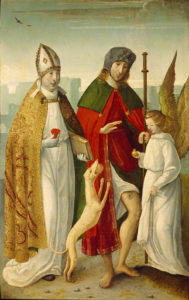Object of the Month: February 2015
St. Augustine and St. Roch
Oil on panel
Juan de Flandes
Flemish, active in Spain, c. 1465–1519
Click on the links throughout the article to view additional artists’ works and reference material.
This intriguing work by the Flemish painter Juan de Flandes was originally commissioned by the Augustinian Convent of St. Miguel de los Angeles. Here a 4th century scholar is paired with a 14th century healer. The painting’s pairing and rich iconographic detail not only highlight two fascinating biographies but also illustrate the power of image as text.
St. Augustine is revered not only as one of the church’s greatest theologians but also as one of the most profound minds of the western philosophic tradition. Born in 354 in Tagaste, North Africa, he was a precocious child who by his early teens had surpassed his tutors. At seventeen, he left Tagaste to continue his education in Carthage. While in Carthage he became enamored with the famous Roman, Cicero. He writes in his Confessions that the study of Cicero’s ideals unleashed in him an overwhelming desire to turn from material pleasures to pursue wisdom. Exploring the popular religious systems of the day, he soon embraced Manichaeism. Augustine held this philosophy for several years, but he later writes that its inability to help him “harness his passions and subdue his ambitious nature” so discouraged him that he cast it aside as a worthless abstraction.
Following his training in Carthage, he taught rhetoric first in Africa, in Rome (in 383), and then in Milan (in 384). It was in Milan that he encountered Bishop Ambrose. In his Confessions Augustine writes: “This man of God welcomed me as a father. As a result, I began to love him, not because of his teaching, but because of his warm and loving personality. I enjoyed hearing him preach, not in order to learn from what he said, but in order to admire and to imitate his eloquence. Indeed, I still despised the doctrines he taught. Yet, by opening my heart to the sweetness of his speech, the truth of his teaching began to enter my soul, little by little.” Augustine soon embraced the Christian faith and Ambrose baptized him in 387. Soon after, the new convert returned to North Africa where he eventually became Bishop of Hippo, ruling in that turbulent African diocese for 34 years until his death in 430.
Like many other figures in religious art, details of Augustine’s life can be pictured through his assigned attributes. For example, he is sometimes shown wearing a bishop’s robes and miter to signify his esteemed position and spiritual vocation; he also sometimes holds a book and pen, symbols of his scholarship and writing. His most common symbol, however, is the flaming heart which represents his passion and love for Christ following his conversion (when pierced with an arrow, it also signifies the death of worldly love). Juan de Flandes uses all of these attributes in his rendering. In so doing, he not only highlights Augustine as a revered and influential scholar but also as a passionate servant whose conversion to Christ ended the tempestuous and relentless spiritual struggle that marked his early years.
St. Roch’s history is as interesting as Augustine’s—though less easily verified and more often mixing fact with fiction. As far as we can ascertain, St. Roch was born in Montpellier, France to a wealthy, influential family. When he was in his early 20s, both his parents died, and following their death Roch distributed his possessions among the poor and set out as a mendicant for Italy. It is here that he first encounters the plague. Overcome by the suffering of a plague-stricken populace, he begins to care for (and according to some stories heal) the sick. As the disease continues its sweep across Italy, Roch travels from city to city helping those in need. Unfortunately when he reaches Piacenza he himself falls ill. Not wishing to burden anyone, he retreats into the woods to die. According to legend, during this time a dog miraculously feeds the ailing saint. In some versions of the story the dog is his own, and in other versions it belongs to another master. In this second variant, the master follows the dog into the forest, finds Roch, and nurses him back to health. Still another version of the story, replaces the animal with an anointing angel. In all versions, however, Roch regains his health and continues his ministry among the sick. At the end of the pandemic, Roch returns home. Ironically, upon arriving in Montpellier he is arrested as a spy and brought before his only surviving uncle who is a judge in the town. Unfortunately, Roch’s illness has so altered his appearance that his uncle fails to recognize him; he is, thus, thrown into prison where he dies five years later.
Like St. Augustine, St. Roch has numerous attributes, and Juan de Flandes integrates them all into this painting. Roch’s traditional pilgrim’s garb and staff (symbols of his mendicant travels) are included. The painter also includes both the dog and the angel, accounting for not one but two variations of the saint’s healing. Roch’s key symbol, a plague boil that appears on his thigh, is also evident.
Almost 1000 years separate the two figures that Juan de Flandes highlights in this work. The pairing of their stories, however, highlights a common theme: the power of a transcendent vision to heal the soul, inspire compassion, and alter the day-to-day affairs of men.
Donnalynn Hess, Director of Education
Published in 2015
